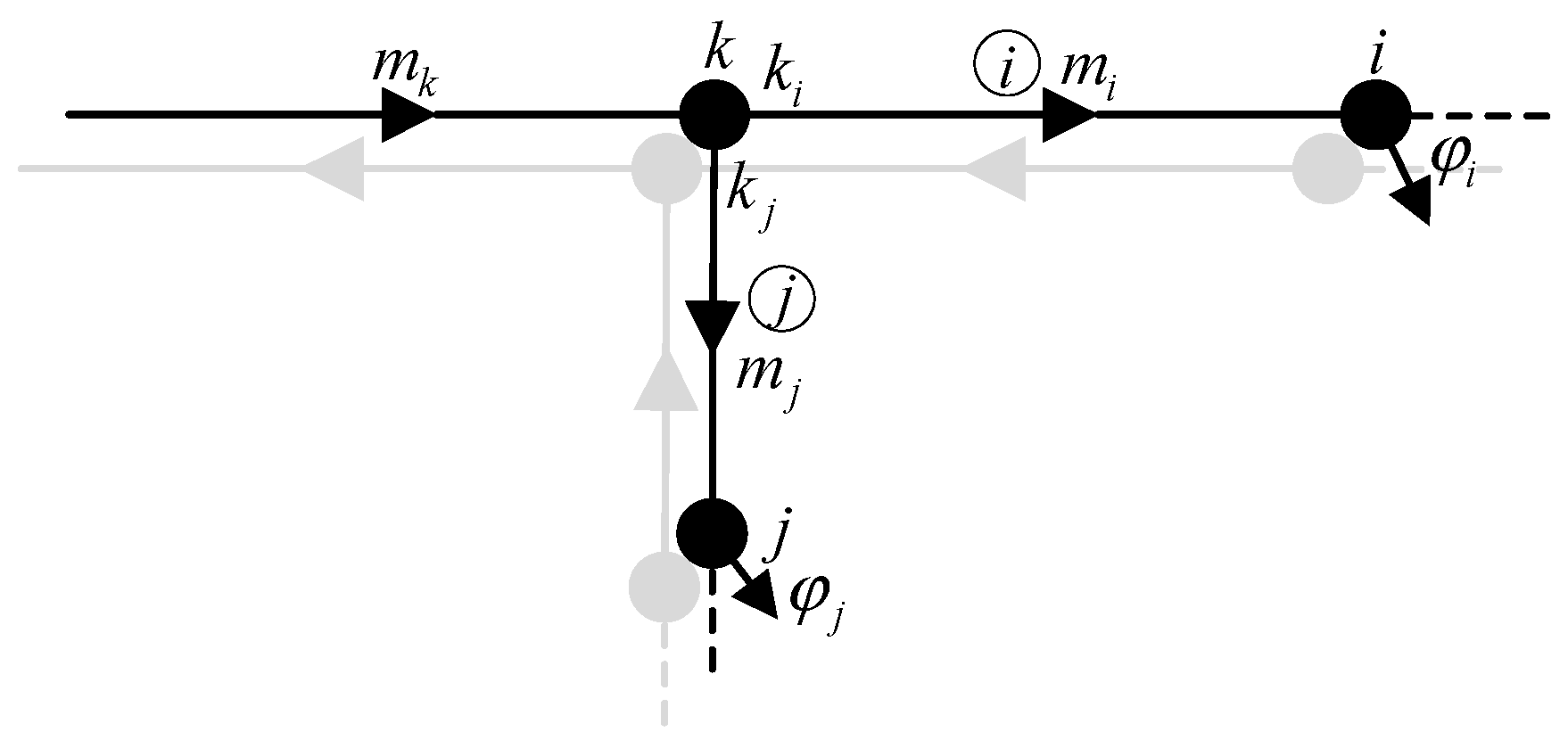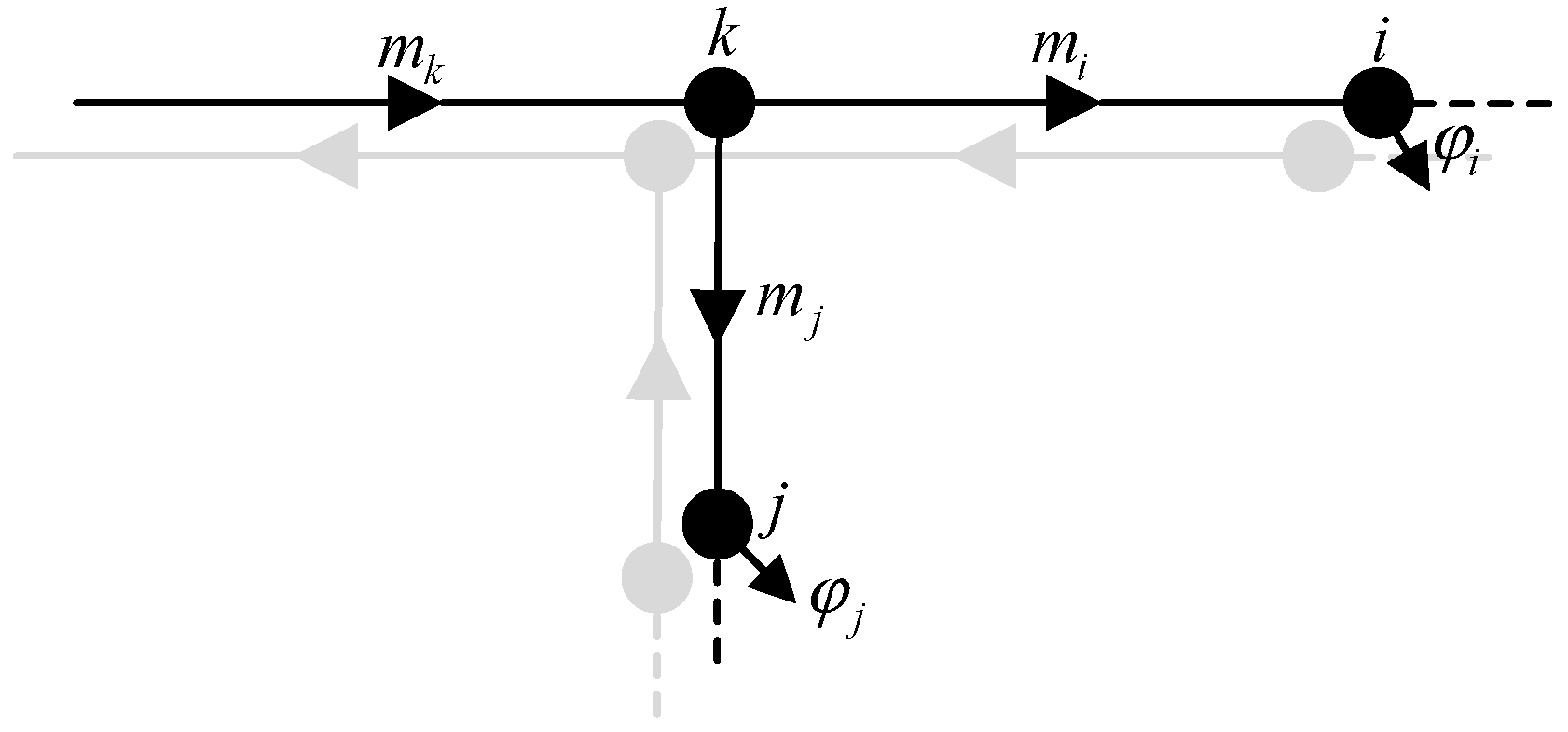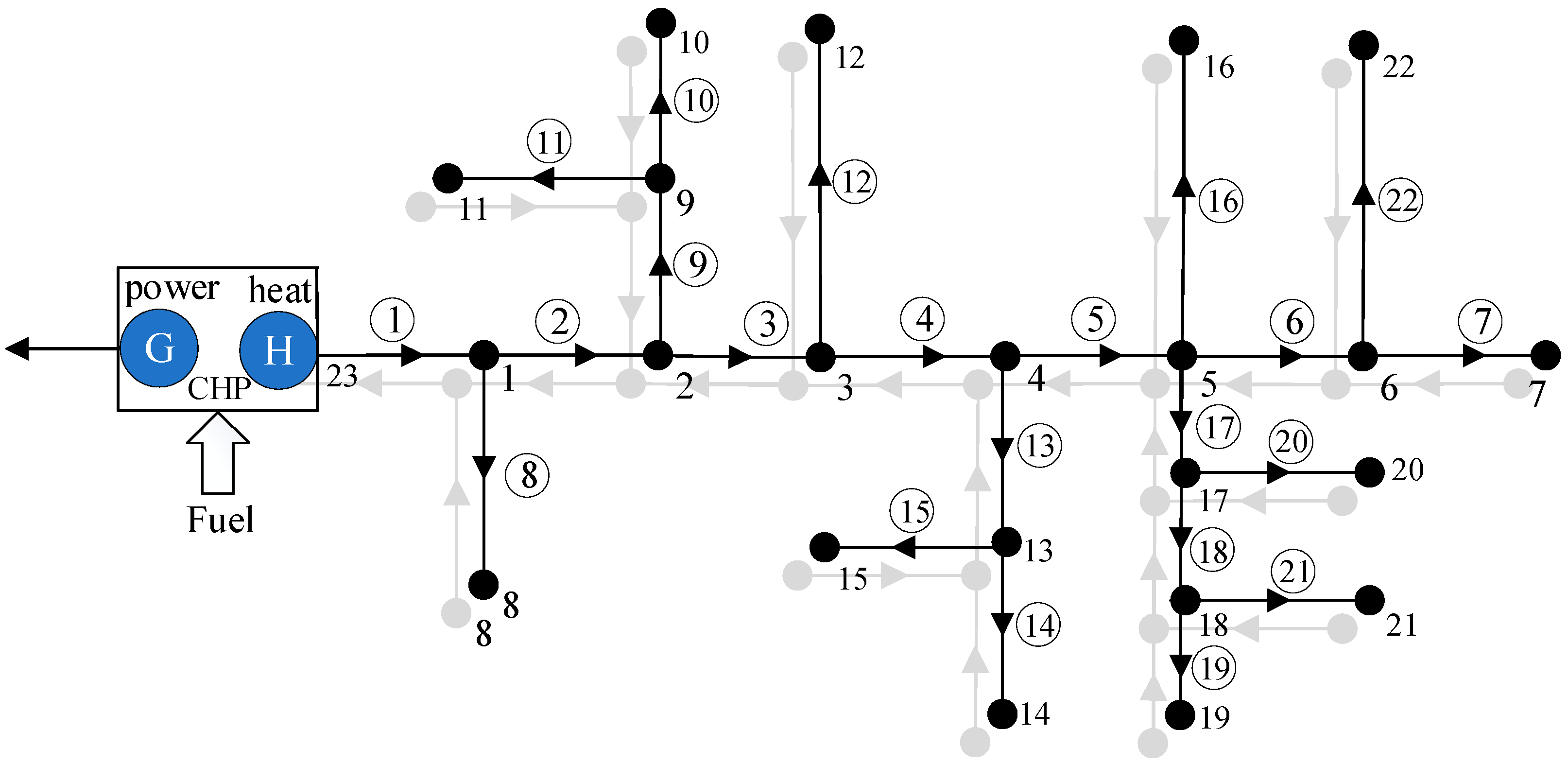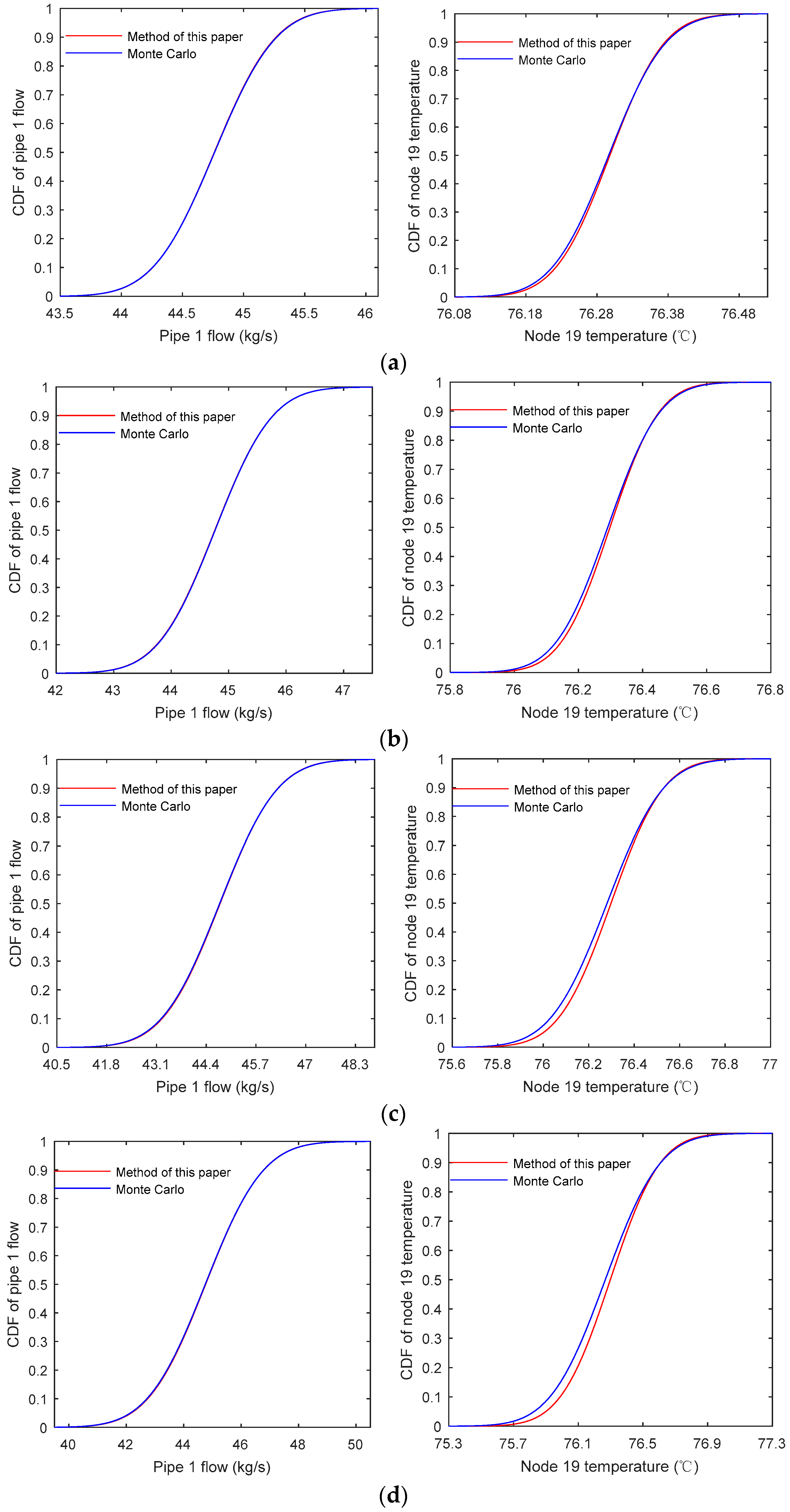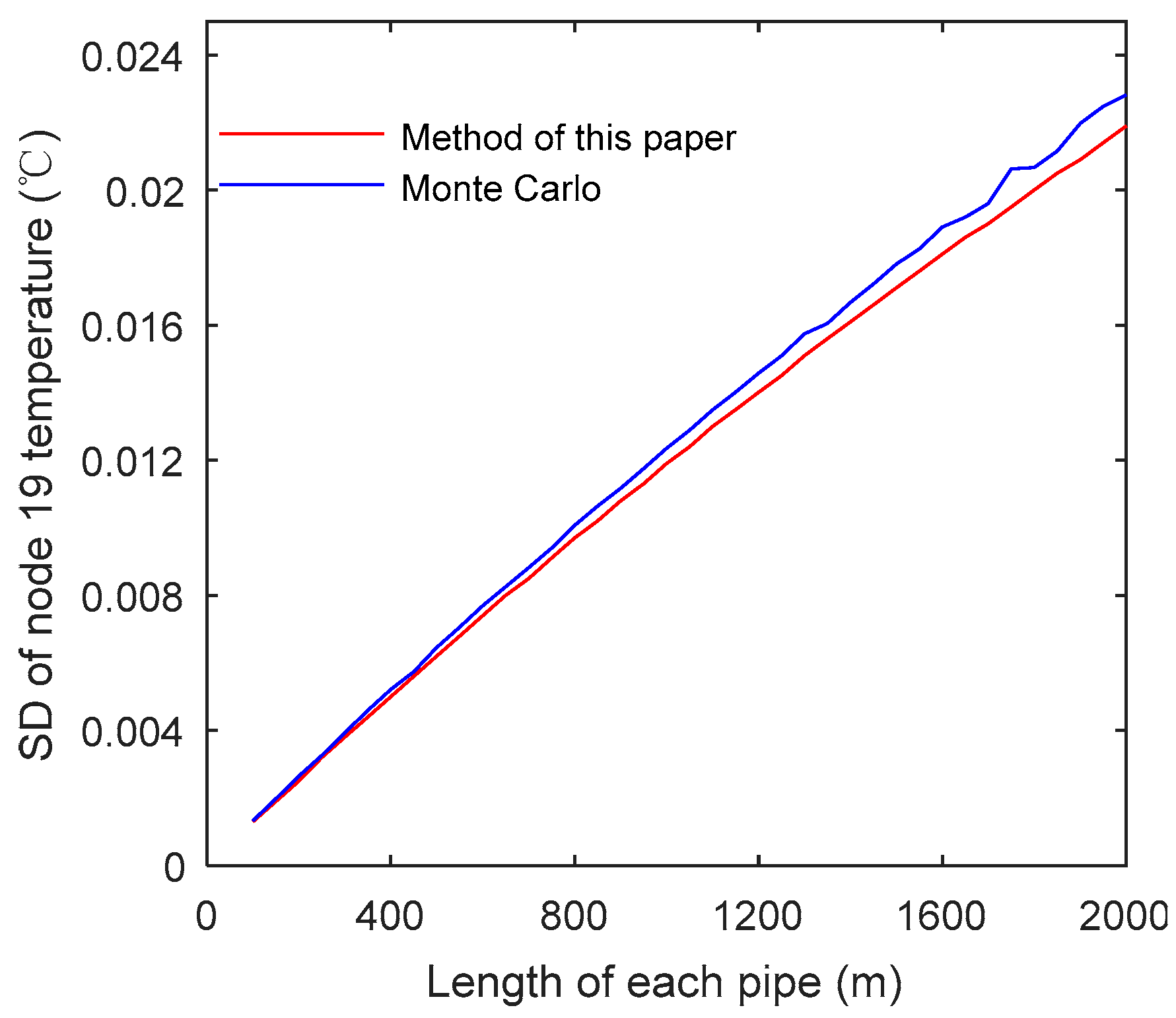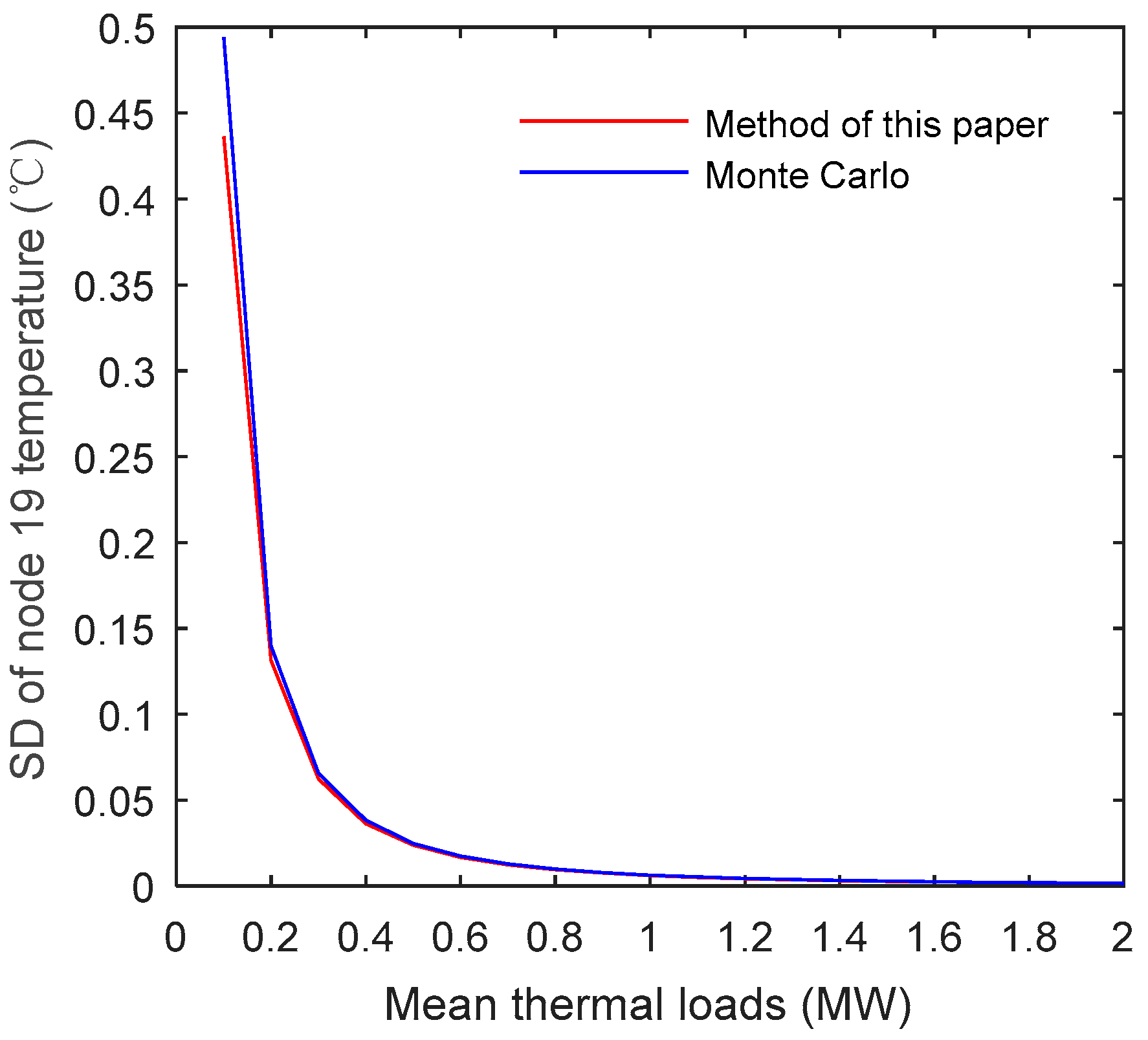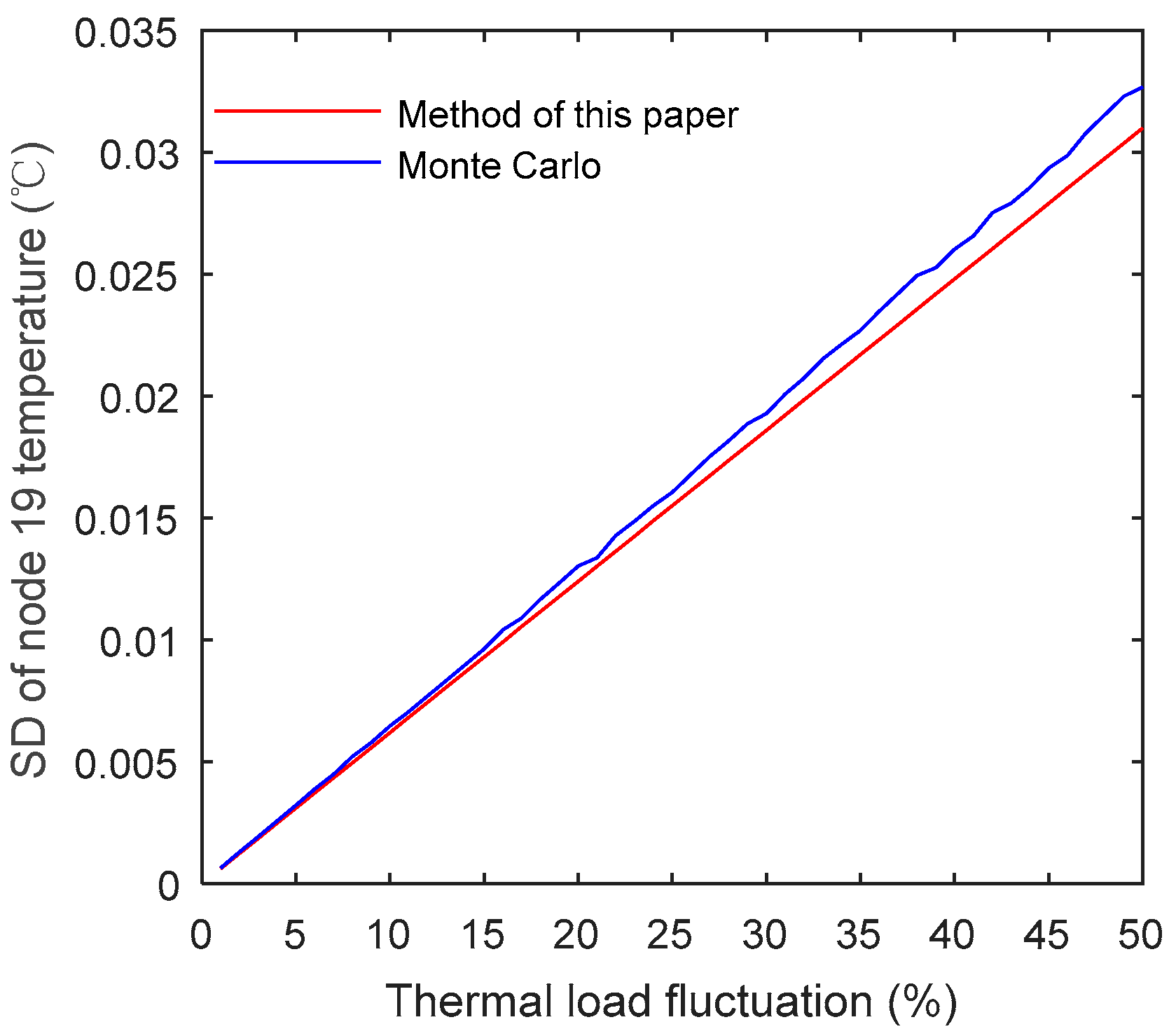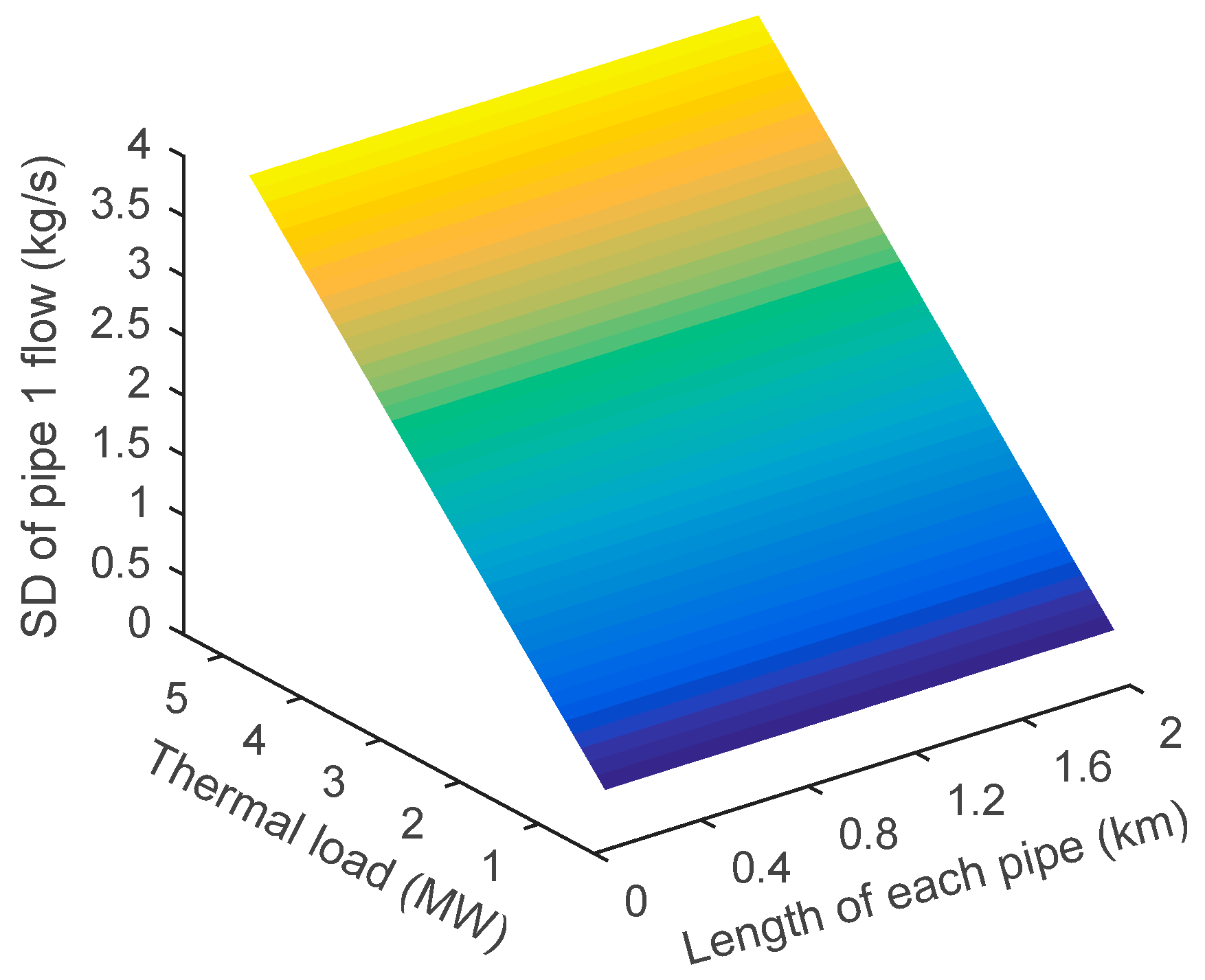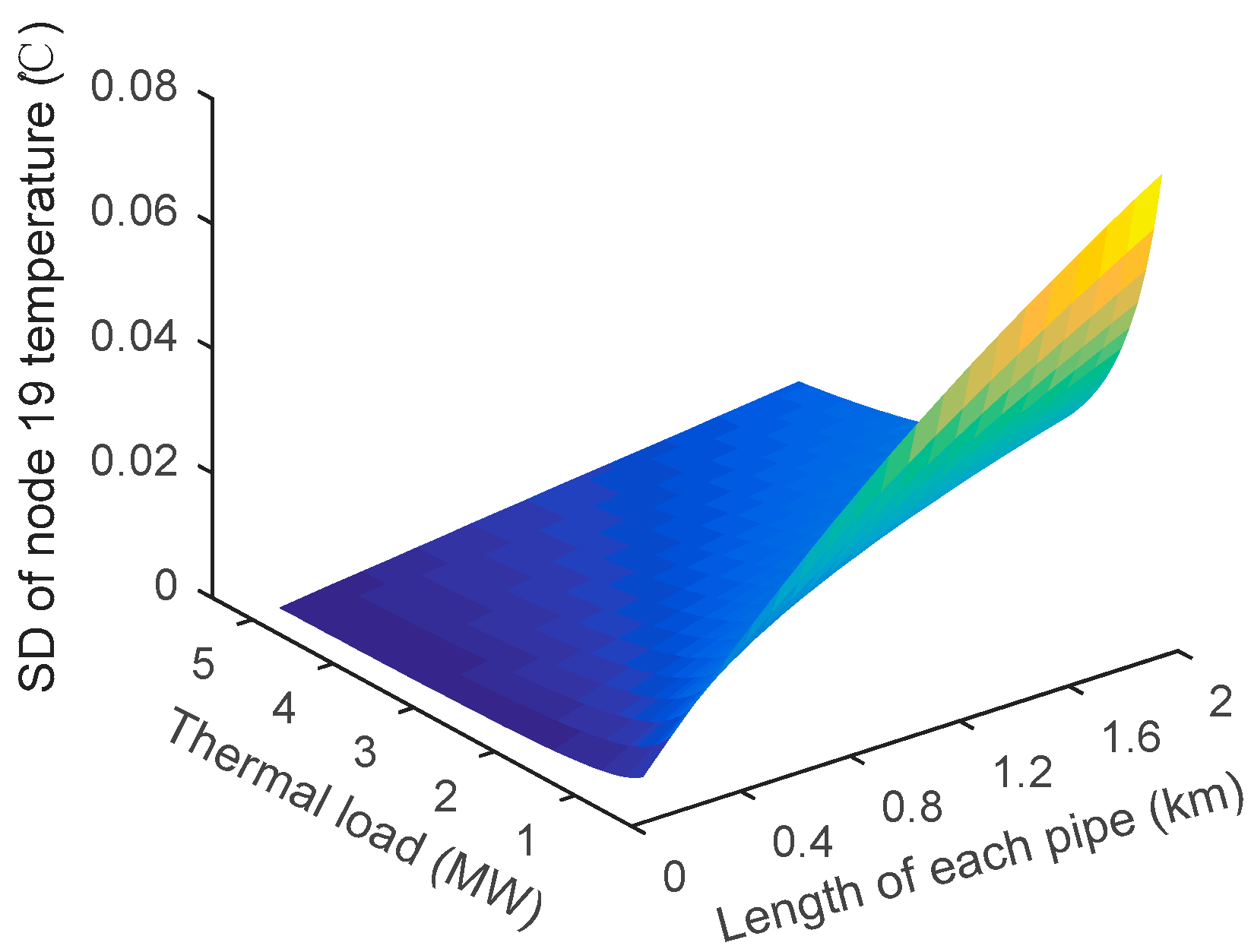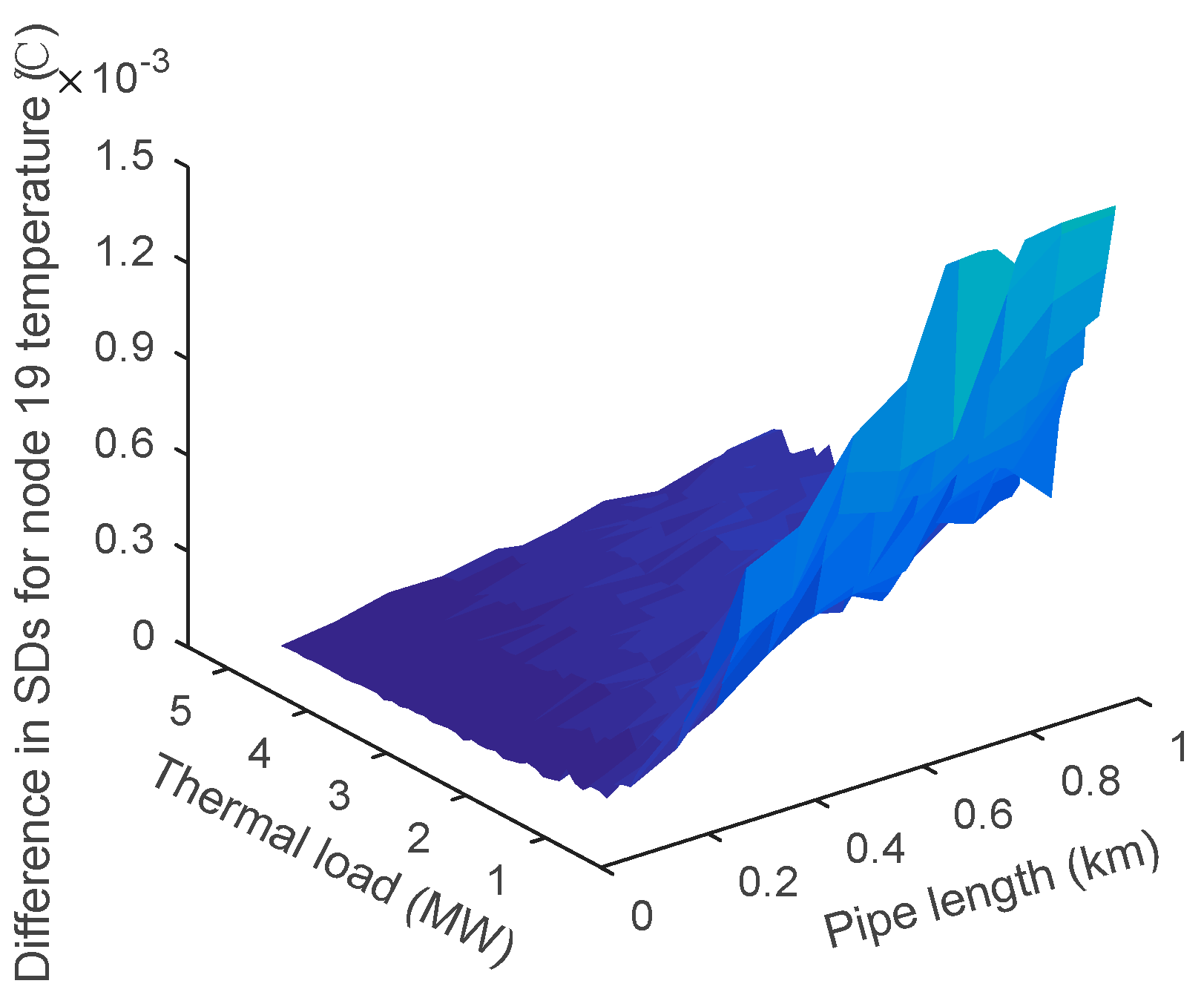2.1. Steady-State District Heating Network Model
The steady-state model of a district heating network includes a hydraulic model and a thermodynamic model. The hydraulic model includes the joint flow equilibrium equation and the pressure head loss equation, which are, respectively, expressed as follows:
where,
A is the node-branch incidence matrix.
m and
mq represents, respectively, vectors of mass flow rate within each pipe and the injected mass flow at the nodes (kg/s).
hf represents the vector of head losses (m), and
K represents the vector of resistance coefficient of pipes. The thermodynamic model includes the thermal load power equation, the pipe temperature change equation, and the node power conservation equation, which are, respectively, given as follows:
where
Φ represents the vector of the heat power consumed or supplied (MW). C
p is the specific heat of water, and C
p = 4182 × 10
−3 MJ·kg
−1·°C
−1.
Ts represents the vector of supply temperatures at nodes (°C).
To represents the vector of the outlet temperature of flow at the outlet of nodes before mixing in the return network (°C).
Tstart and
Tend represents the temperatures at the start node and end node of the pipe, respectively (°C).
h represents the total heat transfer coefficient per unit length (W/(m·k)).
L represents the length of the pipe (m).
Ta represents the ambient temperature (°C).
mout and
min are, respectively, the mass flow rate leaving and entering the node (kg/s).
Tout represents the mixture temperature at the node (°C), and
Tin represents the temperature of mass flow entering the mixing node at the end of the incoming pipe (°C).
Equations (1)–(5) are nonlinear equations, where the coupling relationship between temperature and mass flow is strong, and exponential terms are involved. Therefore, solving these equations for realistic thermal pipe networks directly is quite difficult owing to the high computational complexity involved and the inability for ensuring numerical stability.
2.3. Approximate Model of Probabilistic Mass Flow in a Radial District Heating Network
An approximate model of probabilistic mass flow in a radial district heating network consisting of a heat source node H, three pipes, and three nodes is shown in
Figure 1. Here, the circled values represent pipes, and the arrows represent the direction of mass flow rates. As demonstrated in
Appendix A, the heat loss of a pipe can be estimated as follows:
The thermal power balance equation for the heat source node H and a pipe network consisting of
N pipes and
N nodes is described as:
where
m1 is the mass flow rate of pipe 1,
TH is the temperature of the CHP source,
To is the return temperature of the CHP source,
is the thermal load of node
i, and
is the thermal power loss of pipe
i. Reordering Equation (8) yields an expression for
m1:
These expressions can be simplified according to the following discussion:
Lemma 1. If a real value X lies within a normal distribution N(μ,σ2) (i.e.,), and a and b are real numbers, then.
Lemma 2. Ifand, where X and Y are statistically independent, then the sum of X and Y also satisfies a normal distribution, i.e.,.
It can be seen from Equation (7) that Δ
φ is approximately constant, so that its variance is approximately zero. Assuming that the thermal load obeys an independent normal distribution, it is known from Lemma 2 that
also obeys a normal distribution with a standard deviation
σ. Therefore, the standard deviation of the mass flow rate of pipe 1 can be obtained by Lemma 1 as follows:
Lemma 3. If, where ρ is the correlation coefficient between random variables X and Y, then any non-zero linear combination of X and Y also lies within a normal distribution, i.e.,.
Lemma 4. For two-dimensional random variables, independence and irrelevance are equivalent characteristics.
The correlation coefficient between mass flow rates can be investigated according to Lemma 3 based on the schematic presented in
Figure 2. Here, the correlation coefficient between mass flow rates
mi and
mj is assumed to be
ρij. Because
mi and
mj originate from the same node,
mi and
mj mainly depend on the thermal energy flowing through pipes
i and
j. Therefore, the value of
ρij is very small, and the correlation coefficient between
mi and
mj can be approximated as 0. As can be seen from Lemma 4,
mi and
mj can be considered to be independent of each other. The flow balance equation for node
k can be determined from
Figure 2.
Combining Equation (11) and Lemma 3 yields the following:
Because
ρij ≈ 0, Equation (12) can be given as:
As shown in
Appendix B, setting the sum of all thermal loads flowing through pipe
i to
and its variance as
and setting the sum of all thermal loads flowing through pipe
j to
and its variance as
yield the following expressions:
Because the variance of the mass flow through pipe 1 is known from Equation (10), the variances of the mass flow rate through pipes adjacent to pipe 1 can be obtained according to Equations (14) and (15), and the variances of mass flow rates through all other pipes in the network can be obtained in the same way. This process is generalized as follows.
If
n pipes are connected to node
k and the pipe indices are defined as
i1,
i2, …,
in, then Equations (14) and (15) can be established for all mass flow rates in the pipe network as follows:
Accordingly, the following equations for pipe
i can be obtained:
Here,
Tstarti and
Tendi indicates the temperature at the start and the end of pipe i respectively. Equation (19) can be revised according to Equation (20) as follows:
which can be rewritten as:
If the temperature of node
i is
Ti, the mass flow rate is from H to node
i, and the pipes transmitting the mass flow rates are re-indexed as
x1,
x2, …,
xk, while the temperatures of the nodes are re-indexed as
,
, …,
. This yields the following for pipe 1 in
Figure 1 (i.e., pipe
x1):
while the following is obtained for the pipe 2 in
Figure 1 (i.e., pipe x
2):
Similarly, this can be extended for an arbitrary pipe
xk as follows:
Adding Equations (23)–(25) yields the following:
which can be written as:
Lemma 5. Assume that a continuous random variable X has a probability density function fx(x). It is also assume that a function y = g(x) is monotonous and its inverse function is x = g−1(x). Accordingly, Y = g(X) is a continuous random variable whose probability density function is:
The PDF of a random variable
x =
m obtained from a normal distribution is:
where
ui and σ
i2 are the mean and variance, respectively. Therefore, the probability density function of
y = 1/
x = 1/
mi is given from Lemma 5 as follows:
which can be written in the following form:
Based on the form of Equation (28), if the mean of
y in Equation (30) is 1/
ui, the standard deviation is (
σi·
y)/
ui, where
y = 1/
ui. As such, the standard deviation of Equation (30) is
σi/
ui2, and Equation (30) can be rewritten as follows:
Therefore, if the mean and standard deviation of a random variable x = mi obtained from a normal distribution are, respectively, ui and σi, then y = 1/x = 1/mi approximates a normal distribution, and its mean and standard deviation are 1/ui and σi/ui2, respectively.
Similarly, as shown in
Appendix C, the correlation coefficient between mass flow rate
mk and
mi in
Figure 2 (
ρki) and the correlation coefficient between mass flow rate
mk and
mj (
ρkj) can be obtained as follows:
Lemma 6. Assuming that the correlation coefficient between mass flow rate mA and mB for adjacent pipes A and B, respectively, is ρAB and the correlation coefficient between mass flow rate mB and mC for adjacent pipes B and C, respectively, is ρBC, then the correlation coefficient between mA and mC is ρAC = ρAB·ρBC if only a single unique path leads from pipe A to pipe C.
The correlation coefficients of any two mass flow rates through pipes
x1,
x2, …,
xk can be obtained from Equations (32) and (33) and Lemma 6. Accordingly, assuming that the correlation coefficient between mass flow rate passing through pipes
x1 and
x2 is
ρ12, and
ρ21 =
ρ12, the covariance matrix ∑ of the district heating network can be given as follows:
When a thermal load fluctuates, the temperature change of the corresponding node is relatively small. Then, the temperatures , , …, in Equation (27) are desirable for their mean value, where the error is small at this time and can be approximately ignored.
Lemma 7. IfX = (X1, X2, …, Xn) follows the n-dimensional normal distribution N(a, B) and C is an arbitrary m × n matrix, then Y = C·X follows the m-dimensional normal distribution N(C·a, C·B·CT), where a and B are the mathematical expectation and covariance matrix of the random variable X, respectively.
According to Lemma 7, the probability distribution of (or Ti) in Equation (27) can be obtained from Equations (32)–(34).
